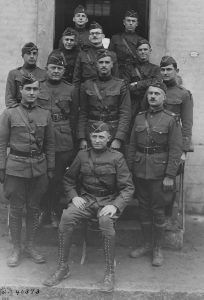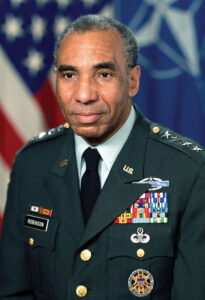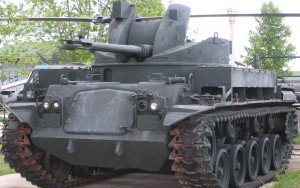Written By: Terrance McGovern
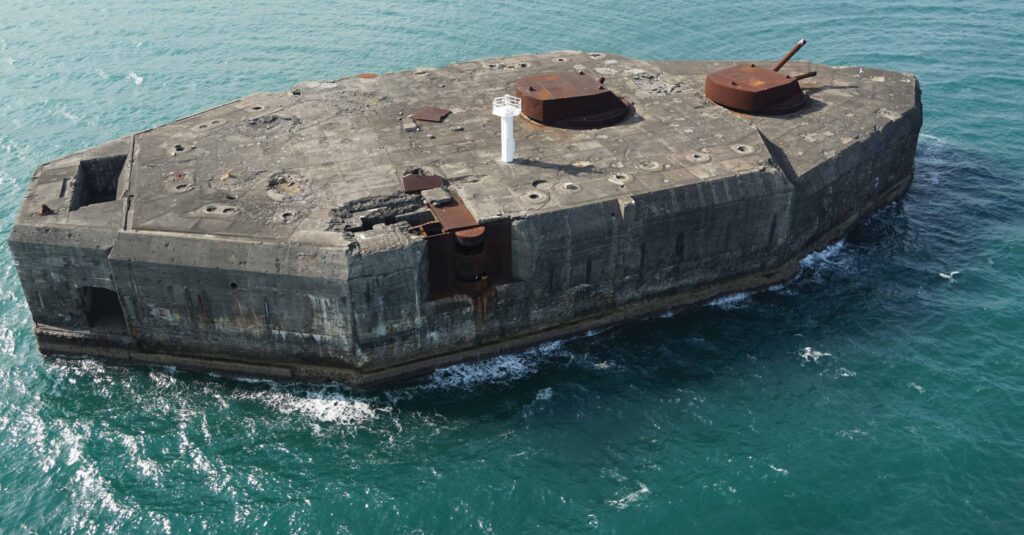
Fort Drum, also known as El Fraile Island, was a heavily fortified site situated at the mouth of Manila Bay in the Philippines, due south of Corregidor Island, in the Boca Grande Channel. Nicknamed the “Concrete Battleship,” Fort Drum looked much like a heavily armed warship at sea. This one-of-a-kind fort was constructed by the U.S. Army Corp of Engineers from 1909 to 1918 as part of the American Harbor Defenses of Manila Bay. Fort Drum was unique among forts built by the Army during the Endicott-Taft fortification period as the fort’s primary armament was two armored turrets, each mounting two 14-inch guns. Additionally, unlike most U.S. fortifications, the fort saw heavy combat during World War II. The fort was named after Brigadier General Richard C. Drum (1825-1909), a veteran of the Mexican War and Civil War who later served as the Army’s Adjutant General (1880-89).
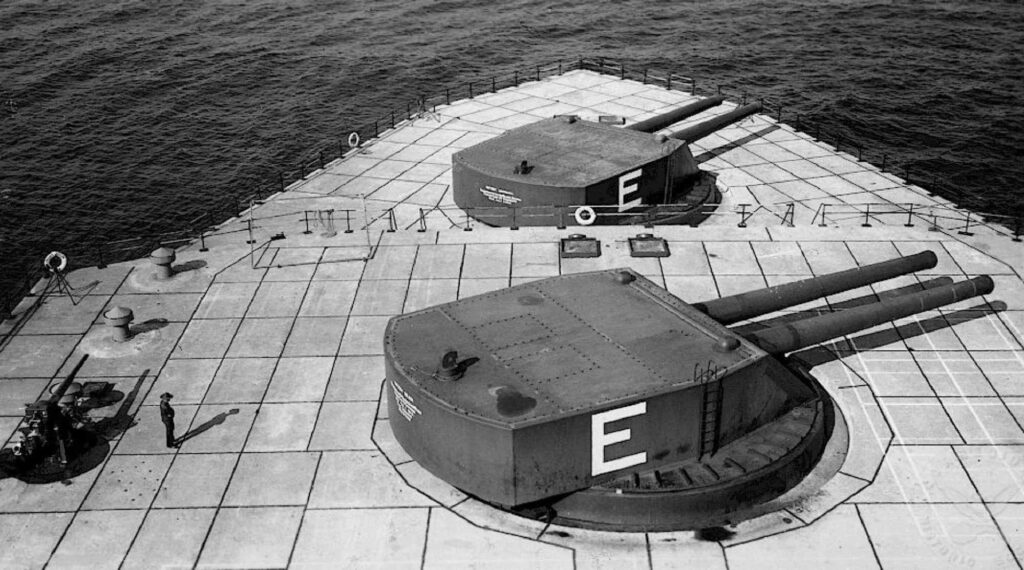
On 12 September 1901, Brigadier General George Lewis Gillespie, Jr., Chief of Engineers, recommended that a board of engineer and artillery officers be appointed to report on the defense of key harbors of the Philippines. While the planned batteries on Corregidor would effectively bar passage into Manila Bay in clear weather, a stormy night or morning haze prevented full coverage of the southernmost channels. When the board submitted its report on the proposed defenses of Manila and Subic Bays in February 1902, it recommended additional defenses on the south shore of Manila Bay, as well as the islands of Carabao, Caballo, and El Fraile, to effectively close the Boca Grande Channel between Corregidor and the Cavite shore. Consequently, the small, rocky El Fraile Island was to be fortified as part of the Harbor Defenses of Manila and Subic Bays.

El Fraile Island, about halfway between the islands of Caballo and Carabao, only measured about 350 feet by 150 feet and was surmounted by a ninety-foot rock pinnacle. Initially, El Fraile was considered by the Army as a location for fire control and a torpedo (submarine mine) casemate. The first U.S. defensive structure built on El Fraile Island was a mine casemate, part of the initial mine project for Manila Bay proposed in 1904. A new 1908 plan for an entirely new defensive work on the island preempted this work.
The closure of Boca Grande Channel to enemy warships took on an even greater importance as the already strained relations between Japan and the United States worsened during the twentieth century’s first decade. A suggestion was put forward for the construction of an artificial island on a shoal just south of El Fraile.
First Lieutenant John J. Kingman, serving on Corregidor in connection with the construction of its fortifications, proposed on 18 July 1908, that El Fraile be utilized instead, as it would be a more effective defense and be far less costly to construct than an artificial island. Kingman’s initial proposal called for reducing the island to near water level and building an elliptical two-story concrete structure mounting two pairs of 12-inch guns in turrets on the structure’s roof. The turrets were originally to have twenty-one to twenty-four inches of nickel steel on the sides and eight to ten inches of armor on their tops. The structure itself was to have exterior walls thirty feet thick; the roof or top deck had ten feet of reinforced concrete. This proposal would undergo a number of changes over the next several months, but the Army eventually adopted Kingman’s basic concept. The final revised design for the projected fort on El Fraile saw the work’s original trace altered from an ellipse to one composed of straight lines in the form of an irregular octagon that gave the structure the general shape of a ship.
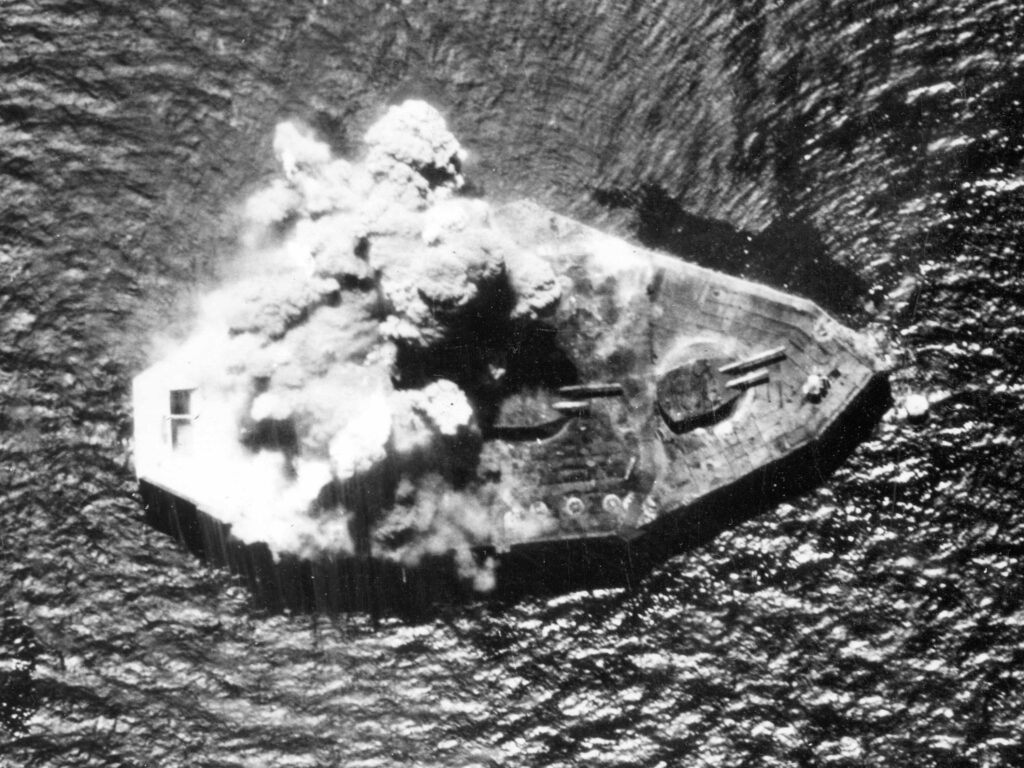
The primary armament was increased from four 12-inch guns to four 14-inch turret-mounted guns at the fort’s western end, with the rear turret firing above the forward turret. Although the Endicott Board had envisioned turrets for use in the American coastal defenses as early as 1886, turrets had proven twice as expensive to produce as standard disappearing gun batteries. The pair of turrets authorized for El Fraile became the first and only such turrets to be manufactured for American coastal defenses. Two secondary batteries, each consisting of two 6-inch guns, were added to the fort’s defenses. These guns would be emplaced in casemates on the fort’s port and starboard sides with one gun mounted above the other in sponsons reminiscent of the secondary batteries on turn-of-the-century battleships.
On 8 March 1909, authority was granted to commence the works on El Fraile. The process of excavation began the very next month. Army engineers erected a cofferdam in the form of a breakwater of timber cribs filled with stone around the projected fort’s perimeter. The island’s leveling began in 1910 and continued into 1911. With the breakwater complete, pouring the concrete foundation began in 1912 and gradually the structure rose above the bay.
Work progressed until June 1918, when the fort was completed. During those nine years, the island was transformed into a reinforced concrete structure some 350 feet long and 144 feet wide, with a top deck forty feet above the water at mean low tide. Overhead protection of the fort was provided by a twenty-foot-thick reinforced concrete deck, while the exterior walls ranged between approximately twenty-five to thirty-six feet thick, making it virtually impregnable to enemy naval gunfire of that era.
Congress appropriated $1,408,000 for the four 14-inch guns and two turrets. Work on the turrets started in 1911 and was completed in 1915. The M1909 turrets were manufactured at the Newport News Shipbuilding and Dry Dock Company in Virginia. The four M1909 14-inch guns were built at Watervliet Arsenal, New York, and their M1909 turret carriages were fabricated at Watertown Arsenal, Massachusetts. The turrets were disassembled, transported to the fort for reassembly, and installed by June 1918.
Each turret’s armor was eighteen inches thick in the front and fourteen inches on the sides and rear, while the turret tops were from 4.5 to six inches inch thick. Each turret had four levels. The uppermost was the gun compartment that was divided longitudinally down its centerline by a fireproof bulkhead. This compartment contained the guns, the sighting and command equipment, gun crew, and loading mechanism. Below the gun compartment was the upper handling room.
Beneath the upper handling room was the electrical compartment, where the switchboards that controlled the power for the various mechanisms in the turrets, the ventilation fans, motor generators, and air compressors for the guns were installed. Below the electrical compartment was the lower handling room, where the concrete walls of the barbette opened onto the passages to the projectile and powder magazines. Projectile service from the magazines to the lower handling room was provided by overhead rail. Powder was moved by hand to the lower hoist.
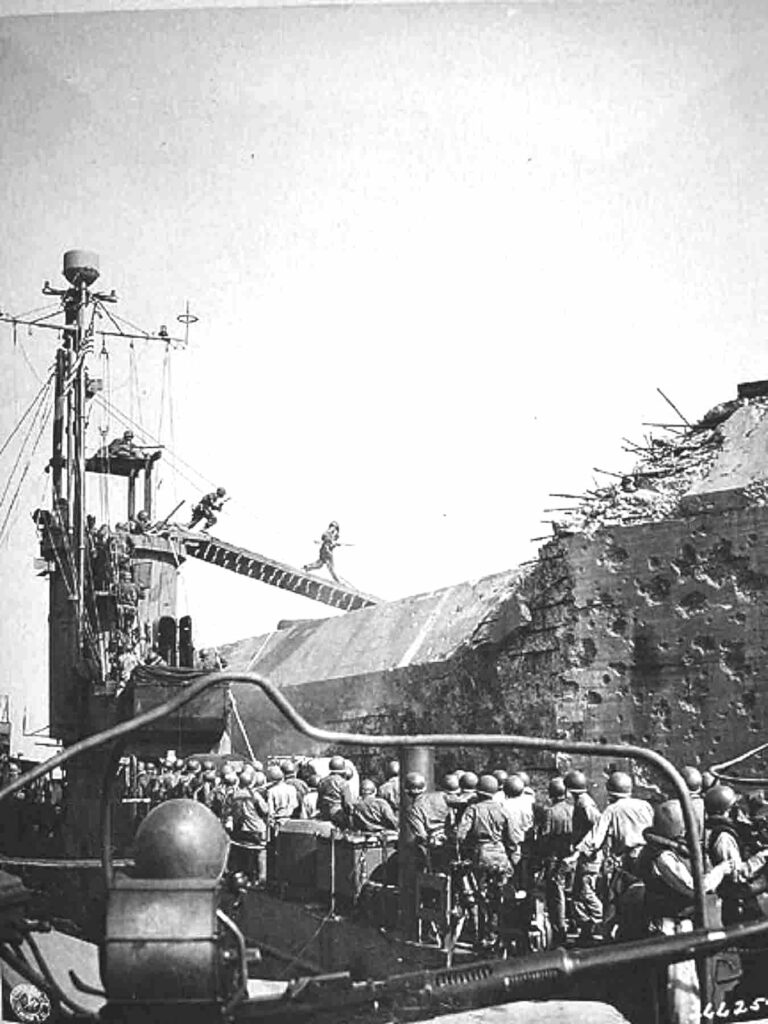
The magazines were to hold a total of 444 rounds. The lower M1909 14-inch gun turret had a traverse of 230 degrees while the upper turret could be traversed 360 degrees. The guns of both turrets could be elevated fifteen degrees and fire a shell out to 19,200 yards. Fort Drum’s secondary armament consisted of four 6-inch M1908MII guns and their M1910 barbette mounts and sponson-type casemate shields that arrived between 1914 and 1916; by early 1917, all had been mounted in their casemates.
One pair of guns was emplaced in the fort’s port (north) side; the second pair on the fort’s starboard (south) side, one gun was emplaced above the other in a semicircular armored casemate behind six-inch-thick armored sponson shields in separate casemates. There were separate powder and shell rooms holding a total of 2,016 rounds for the 6-inch guns. Fort Drum’s batteries remained unnamed until 1922, when General Orders No. 13, 27 March 1922, named the lower 14-inch turret Battery William L. Marshall for Brigadier General William L. Marshall, and the upper turret Battery John M. Wilson for Brigadier General John M. Wilson. Both Marshall and Wilson had served as Chief of Engineers. The two 6-inch batteries were also named, in this case, to honor two artillery officers. The guns on the fort’s northern side were named for Brigadier General Tully McCrea, while the southern battery was named for Brigadier General Benjamin Kearney Roberts.
During peacetime, the assigned Coast Artillery company, quartered on Corregidor, provided a small caretaking detachment, periodically rotated, to maintain the fort. The constrained size of Fort Drum presented real challenges in planning for a garrison. As projected in early 1911, the wartime complement of two full-strength companies would total about 300 men. Following World War I, the garrison was reduced to a single company housed on Corregidor. Allowance for rations was supplied for sixty days in both dry and cold storage. Fort Drum was to obtain its water from evaporators, but it was more convenient to barge water to the post in peacetime. Fresh water storage was in six internal steel tanks with a combined capacity of 27,300 gallons. Fort Drum had a large power plant, water distillation equipment, an ice plant, plotting rooms, and mine casemate. The garrison commander had an office, bedroom, and toilet. Subordinate officers were housed in a dormitory with bunks and toilet. The enlisted men’s barracks on the barrack floor contained 336 bunks and a latrine. Officers had their own mess, as did the enlisted men. Searchlights, fire control stations, and a sixty-foot lattice-style fire control tower were mounted on the fort’s upper area.
When the Army transferred Fort Drum to the Coast Artillery Corps on 17 June 1918, Battery E, 59th Coast Artillery, provided a platoon-sized detachment to man Fort Drum that rotated periodically with another of Battery E’s platoons about every six months. The detachment carried out general maintenance as well as the necessary ongoing care of the ordnance and mechanical systems.
When the annual target practices or harbor defense and wartime-condition training exercises were held, the entire battery went to Fort Drum. The manning of Fort Drum remained the same for many years until the approach of World War II. The fort did not receive its antiaircraft (AA) gun emplacements until 1934, when positions were established on either side of the main deck for 3-inch M1917 AA guns.
Major Lewis S. Kirkpatrick, commanding 2d Battalion, 59th Coast Artillery, was placed in command of Fort Drum in June 1941, with the battalion’s Battery E constituting the 250-man garrison. Upon the outbreak of hostilities with Japan in December 1941, Kirkpatrick oversaw clearing the fort’s upper deck for war. The wooden barracks occupied by the garrison in peacetime was pushed over the side. Beginning on 2 January 1942, Fort Drum withstood heavy Japanese air bombardment which continued on an intermittent basis until the end of the Philippines Campaign. On 6 February 1942, Japanese artillery from the Kondo Detachment began shelling the fort from Cavite with 105mm and 150mm guns.
Damage to Fort Drum was minimal beyond the damage to the cage mast and the destruction of the pair of fixed 3-inch AA guns. Fort Drum’s cage mast contained fire control instruments and searchlights but it created a dead space to the rear of the turrets. It was not removed initially, but as the siege continued the mast became heavily battered, its fire control instrumentation and searchlights wrecked, and if it had fallen, it might have blocked Battery Marshall’s traverse. Additionally, the structure served as an aiming point for Japanese artillery. As a result, the garrison dismantled it and pushed it over the side into the bay.
When the 105mm and 150mm guns fired from Cavite proved largely ineffective, in mid-March, the Japanese began using 240 mm howitzers of the 1st Heavy Artillery Regiment and 2nd Independent Heavy Artillery Battery to bombard Fort Drum and the other island forts.
These howitzer shells had a really “wicked burst.” The recently promoted Lieutenant Colonel Kirkpatrick noted that when a shell struck, the whole fort rocked. On 17 March, a round hit near the No. 1 casemate of Battery Roberts and broke through into the casemate, knocking out the gun and temporarily knocking out the entire battery. It was estimated that Fort Drum was struck by about 3,000 Japanese shells of all caliber; the 240mm shells would crater the deck to a maximum depth of four inches. While this intense shelling led to some armor cracking on the two 14-inch turrets, they continued functioning well, and the high temperatures within the fort warmed the powder charges so the projectiles traveled even farther than designed. Even as Fort Drum endured Japanese air and artillery bombardment, its 14-inch turret-mounted guns of Batteries Wilson and Marshall at provided effective fire support for American forces on Bataan and elsewhere against the Japanese.
Using spotting data provided from an observation post on Malinta Hill, the four 14-inch guns of Fort Drum were especially effective in countering the Japanese batteries on Bataan. However, Japanese guns on the Cavite mainland placed a heavy volume of fire on the concrete battleship; eventually the ability of Battery Marshall’s turret to traverse was reduced by a hit on the base ring beneath the turret. Battery Wilson, however, continued to work against the Japanese on Bataan. With the surrender of the American and Filipino commands on 9 April on Bataan, only the harbor defense forts remained in American hands. On the night of 5 May, the 14-inch batteries of Fort Drum opened fire on the waves of the Japanese forces assaulting Corregidor, sinking several troop barges and inflicting heavy casualties.
However, Fort Drum’s garrison received orders to surrender to the Japanese after the fall of Corregidor on 6 May 1942. Before surrendering at noon that day, Lieutenant Colonel Kirkpatrick ordered that the recoil cylinders of all guns be emptied of oil. He then ordered sandbags to be placed in the gun muzzles and the guns fired with full charges. The garrison then flooded the powder magazines with salt water and threw everything the men could handle into the bay except rations and medical supplies. No U.S. personnel in Fort Drum were killed during the siege and only five men were wounded. Fort Drum was a significant curiosity to the Japanese and was frequently toured by military brass. The 14-inch guns had been damaged at the time of surrender.
At Battery Wilson, the left gun had its muzzle jacket split and the right gun jumped back off its carriage cradle into the turret. Battery Marshall’s right gun was also out of action. Except for damage to Battery Marshall, the saturation bombings of 1944-45 by American aircraft did little other damage to the fort. The September 1945 American damage survey found three large bomb craters on the deck some 30 feet in diameter and three feet deep from 2,000-pound bombs. Other than causing cosmetic damage, these hits did not damage the structural integrity of Fort Drum. Fort Drum was heavily worked over by naval gunnery prior to the attempt at retaking it. In particular, the light cruiser USS Phoenix raked the 6-inch gun casemates at almost point-blank range, penetrating the armor of Battery Roberts.
On 13 April 1945, the 151st Infantry supplied a reinforced company for the assault on Fort Drum. A specially rigged landing craft with a swing ramp brought the infantrymen and elements of the 113th Engineer Combat Battalion to the fort’s deck. Outside of periodic small arms fire, there was no sign of the estimated seventy Japanese defenders. Over 2,200 gallons of fuel mixture were pumped into deck ventilator shafts before being detonated with a 600-pound TNT charge. The first explosion proved deceptively disappointing, but it was soon followed by a massive blast. A twelve-foot-square armored plate over the 6-inch casemate at Battery McCrea flew hundreds of feet into the air before crashing back down on the deck. It took days for the interior to cool enough for an exploratory team to enter. The soldiers found eight dead Japanese on the second floor and sixty more down on the third level. Only three Americans had been slightly wounded in the entire operation.
Nominally El Fraile and Carabao Islands are currently administered by the Philippine Marines, but both are unoccupied. The islands are difficult to access by boat; there are no serviceable wharves or beaches. The abandoned Fort Drum has a remote navigational aid on the deck as its only remaining function. Most of Fort Drum’s internal turret structures, casemates, and even its floor-supporting steel I-beams have been removed by scrappers starting in the 1960s to the present.
Fort Drum was the pride of the American defenses in the Philippines during its roughly thirty years of service. The design of Fort Drum seems to have been a wise concept, though obviously at the cost of time (it took nine years from start to finish) and immense expense. It was so expensive it was never duplicated by Army engineers anywhere else. Nevertheless, the robustness of the design—a virtually impregnable citadel with powerful guns fully protected by stout turrets of wide traverse—was both impressive and held up well during the 1942 campaign. Despite the heavy Japanese aerial and artillery bombardment, its service was never interrupted. The guns continued firing, the ammunition still adequate, and the garrison still full of fight when the fort was ordered to surrender in May 1942.
